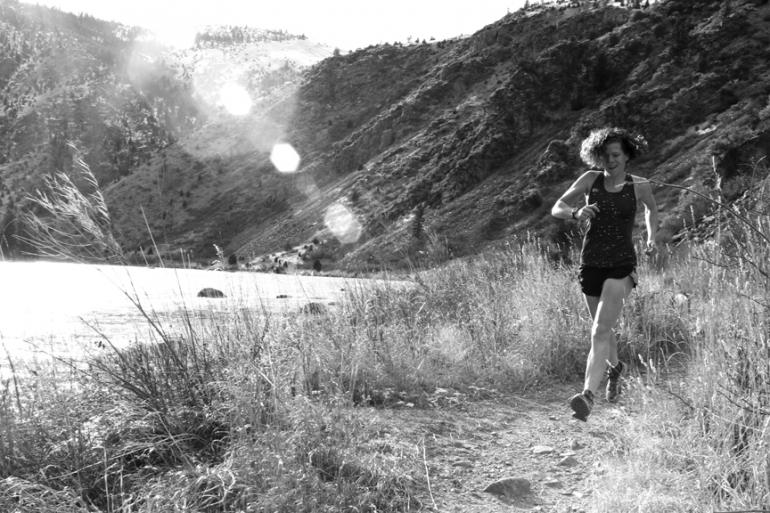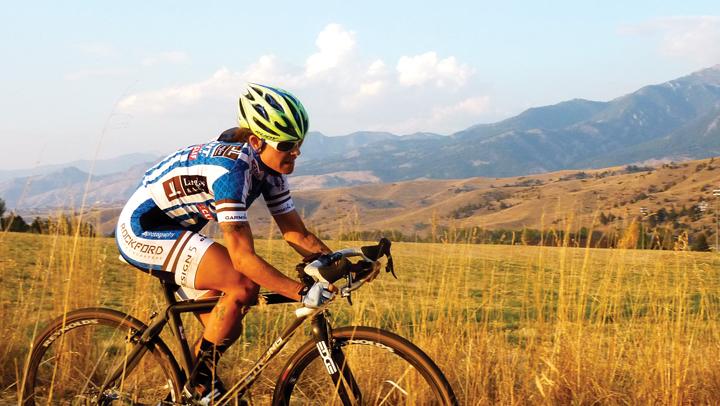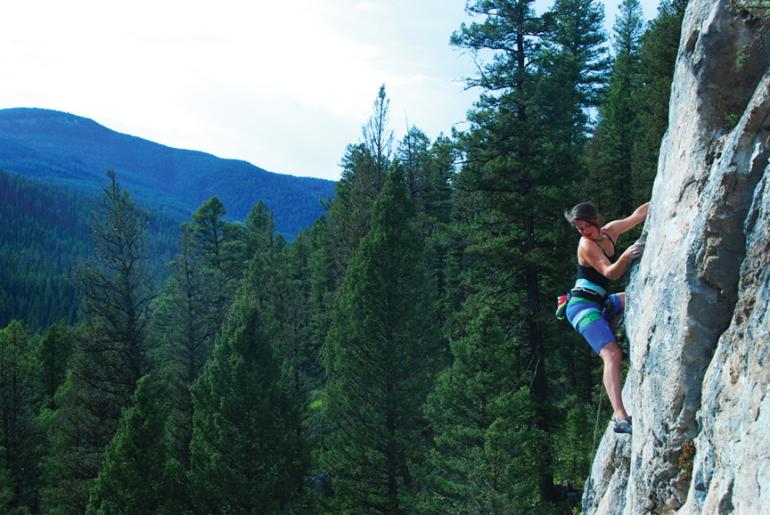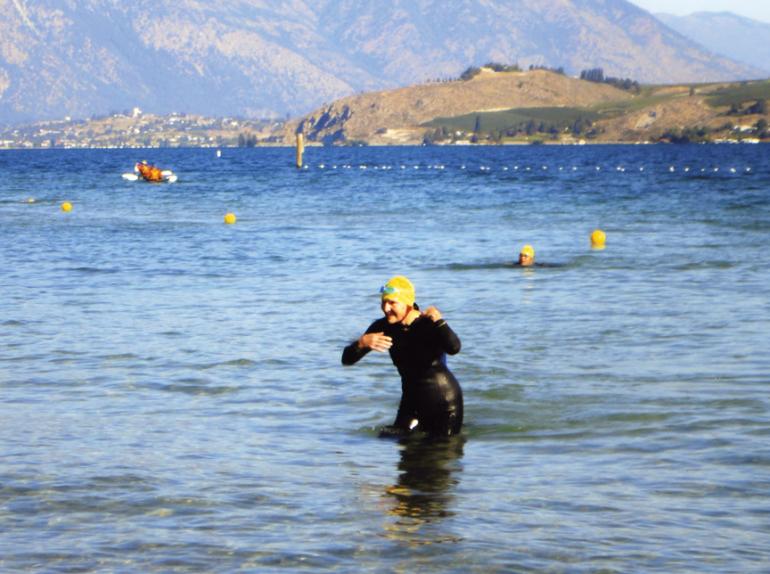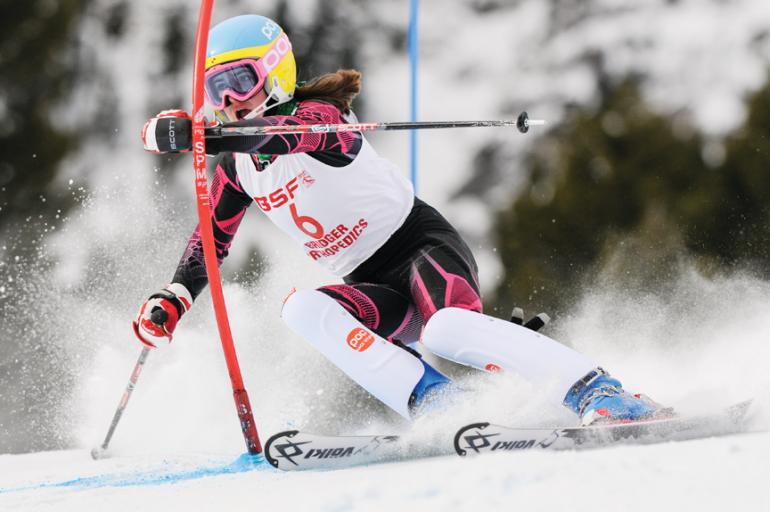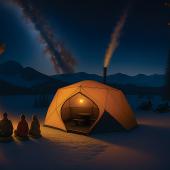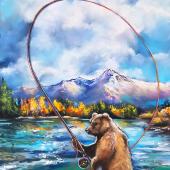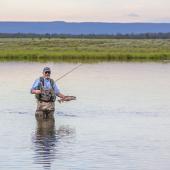Boze-Gals
Pioneering athletes such as Pat Callis, Alex Lowe, Ed Anacker, and Tom Jungst established Bozeman’s reputation as a premier outdoor-sports community. These Boze-Men put up first ascents of ice-climbing routes in Hyalite Canyon, led alpine expeditions to the planet’s wildest corners, conceived of technical trail races such as the Bridger Ridge Run, and discovered audacious new ski-mountaineering objectives in area couloirs and gullies. Bozeman became a Mecca for those who prize the adrenaline rush and earthy connection of outdoor adventure over more material trappings. And the beat went on, with new generations of Bozeman-area thrill-seekers pushing the limits of human-powered sport.
The most significant development in the Bozeman-area outdoor scene in the past two decades, however, has been the emergence of female athletes in pursuits that have traditionally been dominated by men. A case can be made that the people who are currently “getting it done” on the ski hills, running trails, rock faces, and bike courses are disproportionately female: the “Boze-Gals,” if you will. Fear not, Boze-Men, it’s not that you’ve lost your edge—it’s that determined, gritty female athletes are crashing through gender barriers, often kicking some male tail in the process.
The purpose of this article isn’t solely to profile Bozeman’s best female athletes; such a list would no doubt include climber Amy Bullard and Olympic freestyle skier Heather McPhie, among others. Rather, the goal is to provide a snapshot in time by profiling six women (including a set of twins) across a broad spectrum of ages, sports, and competition levels to illustrate the passion and skill of the new face of the Bozeman outdoor scene: the Boze-Gal.
For the most part, Bozeman’s female outdoor athletes feel both challenged and supported by their peers. Exemplifying this esprit de corps is the bond between the youngest and oldest profiled athletes. Since the age of five, twins Erin and Megan Petitt have competed in the community race series at Bridger Bowl and have developed a deep friendship with Molly Hayes, who at age 80 also competes in downhill-ski races. Even though Hayes is old enough to be the twins’ grandmother, their bond is based on the sisterhood of sport.
Nikki Kimball
When The North Face-sponsored ultra-runner Nikki Kimball, 41, toes the starting line of a trail race, her goal isn’t to be the top-finishing female finisher; it’s to win the race outright. She has accomplished this goal several times, and thrice in her career she’s finished top-three overall against fields of national championship caliber or greater. In the 2006 Western States 100, where temperatures reached 101 degrees and nearly half the starters didn’t finish, Kimball outraced 175 of the 177 male finishers. In the 2009 Bridger Ridge Run, Kimball set the existing women’s course record while finishing fifth overall and beating 185 of the 189 men.
Being passed by a woman—known as being “chicked”—is a frequent occurrence in ultra races. Kimball reports, “Even if you’re an elite male ultra runner, chances are, at some point, you’re going to be beaten by a woman. Men have genetic advantages in speed, strength, and size, but the key factors in an endurance race are tenacity, stubbornness, and the ability to deal with pain.” To underscore this theory, Kimball notes, “If a woman finishes in the top five in a highly competitive ultra, chances are the race was contested in unusually difficult conditions: extreme heat, driving rain, or a muddy course. The more daunting the conditions, the more women excel.”
Kimball’s endurance-sports resume is both broad and deep. She was the U.S. National Snowshoe Racing Champion in 2001, 2004, and 2005. In the 2005 World Cup (a 100k road race) she was a scoring member of the U.S. women’s gold-medal team. She has been the top female finisher in the Western States 100 three times, and she set the women’s course record in the prestigious 101.2-mile Ultra-Trail du Mont Blanc. In 2012, Kimball set the women’s speed record for the Vermont Long Trail—a 273-mile super-technical trail—finishing in five days and seven hours, obliterating the old record by two days and eight hours. Her only disappointment is that she didn’t manage to beat the men’s record in the process.
Anna Jo Dingman
Cyclocross (CX) takes a casual cyclist’s nightmare scenarios and combines them into a spectator-friendly extreme sport. The typical CX course contains steep climbs, slick mud and snow, and barriers that can only be overcome by dismounting, shouldering your bike, and surmounting the obstacle. Perfectly sane people are willing to endure 40 minutes of flat-out racing on maniacally designed CX courses—on purpose. One such person is 32-year-old Bozeman resident and Team Rockford member Anna Jo Dingman. Dingman is a slender woman with a bright smile and with whom, at first glance, you wouldn’t associate this mayhem-inducing sport that leaves participants caked in mud, muscles cramping and lungs afire.
Although she has only been racing CX since 2010, Dingman has won the 2011 Rolling Thunder Cyclocross event and the 2010 Jingle Cross race, earned sixth- and ninth-place finishes at the 2013 Chicago CX Cup New Year’s Resolution race, and has garnered top-15 finishes in the Boulder Cup CX, the Los Angeles CX, and the Colorado Classic CX.
Apparently, “normal” CX races are not sufficient to slake Dingman’s thirst for extreme cycling challenges. In 2012, she entered the Crusher in the Tushar, an ultra-CX race in Utah’s Tushar Mountains. She raced conservatively with the goal of merely finishing her first ultra-CX event. Dingman stunned herself and the field by finishing the 69-mile course, with over 10,400 feet of elevation gain, in third place, bearing down on the second place finisher. Dingman plans to enter three ultra-CX events this year with the goal of standing on the top step of the medal podium.
Asked to describe the Bozeman women’s cycling scene, Dingman says, “The women in Bozeman who race are very supportive. It is always a race to the finish, a ‘no friends on a powder day’ mentality, but we are always happy for whoever won the race.”
Jessica Groseth
How passionate are you about your outdoor sport of choice? Climbers, would you be willing to push the pause button on your life to spend the bulk of your waking hours hanging by your calluses onto barely-perceptible rock nubbins, or repeatedly jamming your toes and fingers into a two-inch off-width crack? Jessica Groseth, 31, and her husband Peder quit their jobs at Bozeman-based nonprofits, retro-fitted a van (nicknamed Vandolph) into a home, loaded up their two dogs, and are spending 18 months traveling to America’s top rock-climbing destinations. Since March 2012, they’ve been climbing six days a week, averaging eight to ten pitches a day. Their chalk budget is larger than that of most elementary schools.
The constant exposure to difficult climbing problems has paid dividends for Groseth, who reports that she has overcome her previous fear of falling. Among her notable accomplishments are redpoint ascents of Kyberspace (5.13b) in Ten Sleep Canyon, Wyoming; Taco Chips (5.13a) in Smith Rock, Oregon; Poetic Justice (5.13a) in Rifle Mountain Park, Colorado; and, closer to home, the first female ascent of Cardiac Arete (5.12d) in Hyalite Canyon.
“On a typical day at the crag, women only make up 20 percent of the climbers,” Groseth says. “I think that generally, female climbers are treated the same as anyone else. There was a time, though, when I had left quickdraws hanging on a route called Slash and Burn, a technical and demanding 5.12d at the New River Gorge. I was hoping to come back and do the climb the next day, and when we got there, a few guys were about to try to climb it. They automatically assumed that the draws were Peder’s, and asked him for permission to use them. I’m not going to lie, it felt good when he said, ‘Don’t ask me, they’re not mine. Ask Jess!’”
Erin & Megan Petitt
Imagine that after posting an amazing time in your alpine ski race, you locate your parents in the finishing area. They flash you broad smiles, then they look uphill and start cheering wildly for one of your toughest competitors. This scenario is commonplace for the Petitt twins, Erin and Megan, who are members of the Bridger Ski Foundation’s Alpine Team.
The 13-year-old girls compete in the U.S. Ski Association’s Northern Division U14 age group and they usually carve their way to the top steps of the medal podium. In the 2011-2012 season, Megan had ten top-three finishes out of 15 races, including four in the gold position. Her sister Erin was a top-five finisher in 13 of 15 competitions the same season. At the division race at Bridger Bowl on January 12, 2013, the Petitt girls bested 90 rival skiers by finishing one-two on both days of competition. If you compare the Petitt twins’ finishing times against those of the U14 boys on the same course that weekend, they each posted faster race times than any of their male counterparts.
Their mother, Kerry Petitt, is quick to point out that while the girls are twins, “They’re more like sisters who happened to be born on the same day.” Megan is dark-haired, intense, and results-oriented. Blonde-haired Erin is laid-back, selfless, and a great team-builder. Both, however, are equally passionate about skiing. The Petitt twins’ dedication to the sport is evident in their year-round attendance of dry-land training and roughly 80 days on the slopes each ski season, all while maintaining high academic standards in the classroom. In a sport where “hundies matter,” Erin and Megan are always learning from their coaches and teammates, dreaming of the perfect line, and pushing it to the limit.
Molly Hayes
Molly Hayes, 80, might be the most decorated athlete in Bozeman. She has qualified for the World Triathlon Championship ten times and has won the gold medal in her age group three times. At the 2009 World Triathlon Championship in Australia, she won gold in the sprint race (half-mile swim, 12-mile bike, and 5k run), and the following day she won silver in the Olympic-distance race (1-mile swim, 24-mile bike, 10k run). Over the course of her triathlon career, she has competed in 208 Olympic-distance events.
Asked to cite some of the most challenging moments in her triathlon career—which began in 1986—Hayes says that they tend to involve the swimming segment of the race. Hayes forgot to pack her wetsuit for the 2003 World Championship in New Zealand, so she decided to compete without one. The 55-degree water caused hypothermia, resulting in a trip to the hospital. In Budapest in 2010, the swim was held in a man-made pond created by diverting water from the Danube. She had a bad reaction to the pesticide-laden water and had to withdraw. At the 2011 Nationals, a scheduling oversight released a group of over 100 men of the 45-49 age group into Lake Erie just behind the women’s 75-79 age group, several of whom—including Hayes—were pummeled by the male swimmers to the point that they had to be pulled from the water.
Hayes has experienced first-hand the cultural challenges that women in other parts of the world must cope with. When she competed in the 1978 Persian Marathon in Iran, she refused to wear the mandated body-covering sweat suit, opting instead for a singlet and running shorts. Along the 26.2-mile course, she was cursed by spectators and pelted with rocks and donkey dung. While living in Tabuk, Saudi Arabia, Hayes disguised herself as a man and rode a bicycle to the local market, in violation of gender laws. She was discovered, arrested, and fined $300. After such experiences, Hayes reports that she’s grateful to live in a place where women are an integral part of the athletic community.
Photos by Jaime Jacobsen, Ryan Hamilton, Jessica Groseth, Molly Hayes, Paul Bussi


